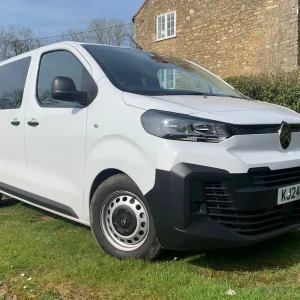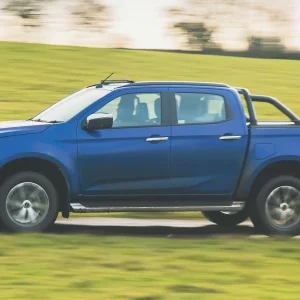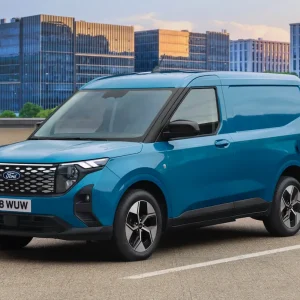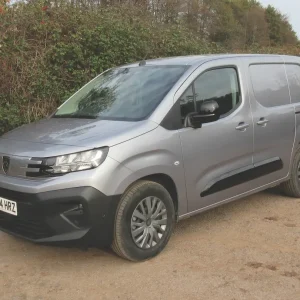The Transit juggernaut just keeps rolling on. Last year saw Ford sell over 26,000 examples of its iconic van in the UK, making it the country’s second most popular light commercial. The number one slot was occupied by another model with a Transit badge – the Transit Custom – with upwards of 52,000 registrations.
Marketed in both front- and rear-wheel drive guise as well as with four-wheel drive, what is now sometimes referred to as the ‘big Transit’ underwent a makeover a while back. It got a redesigned front end with a taller three-bar grille, plus reshaped front panels and a reshaped front bumper, a revised interior, a new 185hp version of its 2.0-litre Ecoblue diesel, and the option of a mild hybrid diesel powertrain.
The 2.0-litre has been upgraded, with peak fuel injection pressure now set at 2,200 bar. Other changes include the introduction of a variable-flow oil pump intended to reduce parasitic losses by adapting oil delivery to demand.
An all-electric Transit is scheduled to go on sale in 2021, and rear-wheel drive Transits will be made available with a 10-speed automatic gearbox. That’s a development likely to gladden the heart of anybody involved with home delivery work.
Front-wheel drive variants are already on sale with a SelectShift six-speed auto gearbox.
Grossing at from 2.9t to 4.7t, Transit vans can handle a gross payload of from 872kg to 2,169kg depending on the model selected. Load cube ranges from 9.5m3 to 15.1m3 and the Transit is also available as a crew van with rear seats plus a separate load area, a chassis cab, a chassis crew cab, and as a minibus.
Power comes courtesy of the aforementioned 2.0-litre engine in all cases, at 105hp, 130hp and 170hp, as well as at 185hp. It is also used in the hybrid, with 130hp on tap.
Three specification levels are offered: entry-level Leader, Trend, and top-of-the-range Limited.
We got behind the wheel of a rear-wheel drive 185hp 3.5t L3H2 van in Limited trim with a 11.0m3 load area and the standard six-speed manual gearbox. We came away impressed.

Load bay
Access to our test vehicle’s loading area was by means of a sliding nearside door that opened to reveal a step and a grab handle, or through twin rear doors that could be opened to 90°. They could be swung through a full 180° once the stays were released. All you needed to do to unfasten each of them was push a button.
The rear bumper incorporated a step.
A grab handle on one of the rear door pillars – preferably on both of them – would have been welcome. Rear-wheel drive means that the rear loading height is higher than it is on front-wheel drive models, so you sometimes need something to help you haul yourself aboard.
A full-height bulkhead separated the cab from the cargo area, and 10 load lashing points were fitted. Plastic mouldings protected the load bay’s sides, doors and wheel boxes from minor damage, and the cargo bed was protected by a tailored cover.

Interior and equipment
Our Transit’s three-seater cab was not short of storage space, with shelving above the windscreen cleverly incorporating grab handles adjacent to the A pillars, four shelves on top of the dashboard, and a large, lidded and lockable glovebox with a shelf above it.
There were bottle and cupholders at each extremity of the fascia, plus a pull-down cupholder housed in the moulding that accommodated the gear lever.
Big bins in each of the doors were shaped to grasp a bottle or a flask, and the centre section of the middle seat’s back could be folded down to create a handy desk. It featured an elasticated strap to keep paperwork in place, a recess for your pens and two more cupholders.
Anybody who occupied the middle seat suffered from legroom that was slightly restricted.
When we pulled up the cushions of the passenger seats we found a large hidden compartment big enough to conceal power tools and other items that thieves would find attractive.
Complete with an inboard armrest and lumbar adjustment, the Transit’s driver’s seat was height-adjustable, as was the leather-trimmed steering wheel, home to the DAB radio’s remote controls. The gear knob was leather-trimmed too.
In-cab equipment included a driver’s airbag, air-conditioning, and an 8in TFT touchscreen in the middle of the fascia.
Ford Sync3 was installed, which integrates with compatible smartphones and allows drivers to use the touchscreen or voice commands to control everything from phone calls and text messaging to music and satellite navigation. AppLink enables Sync-compatible apps to be controlled. Emergency assistance helps the driver contact the emergency services if there is an accident and pinpoint the vehicle’s exact location.
Electric windows and heated and electrically adjustable and folding exterior mirrors were fitted, with each of the latter featuring a lower wide-angle section.
Two 12V power points plus a USB socket were provided, along with Bluetooth connectivity.
Reversing sensors were installed, and could be switched off. Sensors were provided at the front too to make it easier to park in tight spaces, and our demonstrator came with side park assist to make things even simpler. Ultrasonic sensors warn if the van’s flanks are too close to an obstacle.
Our van’s 16in alloy wheels were shod with Michelin Agilis 235/65 R16C tyres.
Front fog lights were included in the deal, along with bright bi-xenon headlights with LED daytime running lights, plus a Quickclear heated windscreen and rain-sensing windscreen wipers.
The list of onboard safety systems seemed endless, which is by no means a cause for complaint. It included ABS, electronic stability control, electronic brakeforce distribution, hill start assist, emergency brake assist, emergency brake warning, roll stability control, side wind mitigation, and cruise control with adjustable speed limiter.
Disc brakes were fitted all round.

Engine and gearbox
Equipped with common-rail direct fuel injection and a variable geometry turbocharger with electric actuation, the Transit’s 16-valve four-cylinder in-line diesel developed its maximum power output at 3,500rpm.
Maximum torque of 415Nm kicked in across a usefully wide 1,750-2,750rpm plateau.
Diesel Transits rely on a diesel particulate filter and selective catalytic reduction to meet the Euro 6.2 exhaust emission standard.
Selective catalytic reduction uses AdBlue. The 21-litre reservoir top-up point is under a flap adjacent to the passenger door along with the cap-less Easy-Fuel diesel filler point.
Last autumn saw this engine suffer injector problems that Ford has been busy resolving. It says that they will not affect new orders.
Driving
The Transit’s independent front suspension featured independent MacPherson struts with variable-rate coil springs plus a stabiliser bar, while leaf springs helped to support the rear. Gas-pressurised shock absorbers were fitted all round.
Electric power-assisted rack-and-pinion power steering delivered a 13.3m kerb-to-kerb turning circle.
Strong acceleration away from rest to the accompaniment of Ford’s excellent-as-usual gear change made for a good start.
With plenty of power on tap, the 185hp Transit proved more than capable of handling high-speed motorway runs, but was equally at home tackling steep rural hills fully laden. That was when all the torque that is on tap really came into its own.
Heading down the steep, twisting, A46 from the M4 motorway towards Bath city centre in driving rain, we were grateful for the Ford Transit’s precise, predictable handing. As we swung the wheel from left to right and splashed through the surface water we silently applauded the grip delivered by the light commercial’s Michelin tyres as they clung to the increasingly sodden highway.
The presence of curve control may have helped. It is designed to ensure you remain in charge of your van if you go into a bend too quickly. If it detects understeer and senses you may be about to lose control, it reduces engine torque then applies the brakes to help slow you down.
While our test Transit rode well, there was a touch too much bumping and thumping from the suspension even on smooth highways. Engine noise could be intrusive too, although neither of these criticisms amounted to major issues.
Auto stop-start was fitted, which helped to keep fuel usage down, as did using the Eco setting on the mode switch. Resorting to it alters the vehicle’s torque setting and rate of acceleration among other functions. Such systems typically cut a vehicle’s fuel consumption by around 10%.
The switch’s Slippery mode alters the electronic stability control and traction control settings to deliver better grip on mud, snow and ice.

Operating
Service intervals are set at two years/25,000 miles with a one-year/10,000-mile interim inspection recommended – a wise precaution given the different ways in which LCVs are used. A parcel company’s duty cycle, for example, differs significantly from that of a carpet fitter.
The Transit is covered by a three-year/100,000-mile warranty.
Fuel economy? We achieved a steady 40mpg, just shy of the official combined figure, and would probably have done a lot better had we remembered to press the Eco button.
Side rubbing strips plus protection for the wheel arches helped defend the Transit against minor bumps and bangs. Build quality was good overall, although the tatty bits of foil that shrouded some of the wiring under the bonnet caused us to raise an eyebrow.
Our Transit was not equipped with a spare wheel, alas. Instead, it had a tyre inflator stowed under the driver’s seat – which is not a whole lot of use if you drop one of your wheels into a deep pothole and end up with a badly gashed sidewall.
Ford Transit Limited 350 L3 H2 2.0L EcoBlue 185hp RWD
Price (ex VAT) £36,900
Price range (ex VAT) £26,235-£38,600
Gross payload 1,332kg
Load volume 11.0m3
Load length 3,494mm
Load width (min/max) 1,392/1,784mm
Load bay height 1,786mm
Loading height 608mm
Rear door aperture 1,565×1,648mm
Side door aperture 1,300×16,00mm
Gross vehicle weight 3,500kg
Braked trailer towing weight 2,800kg
Residual value 20.5%
Cost per mile 67.1p
Engine size/power 1996cc, 185hp @ 3,500rpm
Torque 415Nm @ 17,50-2.750rpm
Gearbox 6-spd
Fuel economy 41.5mpg (combined)
Fuel tank 70 litres
CO2 177g/km
Warranty 3yrs/100,000mls
Service intervals 2yrs/25,000mls
Insurance group 49A
Price as tested £37,550
Options fitted
Metallic paint £650
Rivals
Mercedes-Benz Sprinter
Price (ex VAT) £26,120-£53,210
Load volume 7.8-17.0m3
Gross payload 804-2,547kg
Engines 114hp, 143hp, 163hp 2.1 diesel, 190hp 3.0 diesel
Verdict: Businesses who view safety and connectivity as their priorities should head straight for the Sprinter. Noted for being able to endure hard graft, it is available with front-, rear-, or four-wheel drive, and an electric model is in the pipeline. Check out its automatic transmissions: a seven-speeder is available on rear-wheel drive variants while a nine-speeder can be specified on its front-wheel drive stablemates.
Peugeot Boxer
Price (ex VAT) £24,735-£34,630
Load volume 8.0-17.0m3
Gross payload 725-1,570kg
Engines 120hp, 140hp 2.2 diesel
Verdict: With the Transit hogging so much of the light commercial limelight, the Boxer has always been somewhat underrated. That is a pity because it is both capable and well-equipped. It was revised not long ago with a new engine and trim changes, developments it shares with its Citroen Relay close cousin. Sharing the same basic design, Fiat Professional’s Ducato has been revised too, and all three models are worth a look.
Volkswagen Crafter
Price (ex VAT) £25,790-£43,170
Load volume 9.3-17.5m3
Gross payload 735-2,573kg
Engines 102hp, 122hp, 140hp, 177hp 2.0 diesel
Verdict: Operators seeking a well put-together LCV with the accent on safety as well as durability should take a look at the Crafter. Its front assist with city emergency braking package is a potential life-saver. A battery-powered e-Crafter is on its way, and don’t forget the Crafter is also marketed by MAN as the TGE. A key reason for opting for the TGE is the ability of the MAN network to provide truck-style 24/7 support.
The Final Verdict
|
Design |
8/10 |
Practical, well put-together, and ticks almost all the boxes. |
|
Cabin |
8/10 |
Well-equipped, with lots of storage space and comfortable seating. |
|
Ride |
8/10 |
Better than what is on offer from many of the Transit’s rivals. |
|
Refinement |
7/10 |
Good, aside from minor issues with engine and suspension noise. |
|
Load area |
7/10 |
Beefy bulkhead, but rear door pillars should have grab-handles. |
|
Handling/performance |
8/10 |
Both are to a an impressively high standard. |
|
Engine/transmission |
9/10 |
Well-matched, with Ford’s slick gear change worthy of applause. |
|
Standard equipment |
8/10 |
Limited trim gives you almost all the goodies you need. |
|
Operating costs |
8/10 |
Respectable fuel economy and a sensible warranty. |
|
What Van? subjective rating |
8/10 |
Yet another praiseworthy package from Ford. |
Overall Rating = 79/100





